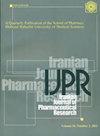优化 ZIF-8 纳米粒子的合成和放射性标记
IF 1.8
4区 医学
Q3 PHARMACOLOGY & PHARMACY
引用次数: 0
摘要
背景:最近,人们对金属有机框架的益处越来越感兴趣,其中,沸石咪唑啉框架(ZIF - 8)因其独特的特性而成为最常用的系统之一。研究目的鉴于粒度等特性在纳米粒子的生物医学应用中起着关键作用,优化合成条件变得至关重要。此外,对这些纳米粒子进行标记以便在体内对其进行有效追踪也至关重要。方法:使用两种不同的溶剂,在高温和室温等不同条件下合成沸石咪唑盐酸盐框架纳米粒子:水和甲醇。对反应温度和反应物比例进行了调整,以改善结果。在所有条件下都对粒度和粒度分布进行了评估。此外,还使用四种不同的方法对纳米粒子的放射性标记进行了检测,以确定效率和放射化学纯度最高的方法。结果以甲醇为溶剂,在 50°C 下确定了合成 ZIF-8 的最佳条件。反应物重量比为 1 : 2(硝酸锌和 2 - 甲基咪唑)。最有效的放射性标记方法是使用氯化亚锡作为还原剂,将反应混合物保持在 70°C 的温度下 30 分钟。结论本研究成功确定了合成和标记 ZIF-8 纳米粒子的最佳条件。这些纳米粒子有望成为诊断和治疗药物的有效载体。本文章由计算机程序翻译,如有差异,请以英文原文为准。
Optimization of the Synthesis and Radiolabeling of ZIF-8 Nanoparticles
Background: Lately, there has been increasing interest in the benefits of metal-organic frameworks, and among them, zeolitic imidazolate frameworks (ZIF - 8) stand out as one of the most commonly employed systems owing to their unique characteristics. Objectives: Given that properties like particle size play a key role in biomedical applications of nanoparticles, optimizing the synthesis conditions becomes crucial. Additionally, it is essential to label these nanoparticles to track them effectively within the body. Methods: Zeolitic imidazolate frameworks nanoparticles were synthesized under various conditions, including high and room temperature, using two different solvents: Water and methanol. Modifications were made to the reaction temperature and the ratio of reactants to improve the outcomes. Particle size and size distribution were assessed in all conditions. Additionally, the radiolabeling of nanoparticles was examined using four different methods to identify the method with the highest efficiency and radiochemical purity. Results: The optimum conditions for ZIF-8 synthesis were determined at 50°C using methanol as the solvent. A reactant weight ratio of 1 : 2 (zinc nitrate to 2 - methylimidazole) was utilized. The most effective radiolabeling approach involved using tin chloride as a reducing agent, with the reaction mixture maintained at a temperature of 70°C for 30 minutes. Conclusions: In this study, the optimum conditions were successfully identified for synthesizing and labeling ZIF-8 nanoparticles. These nanoparticles have the potential to serve as effective carriers for diagnostic and therapeutic agents.
求助全文
通过发布文献求助,成功后即可免费获取论文全文。
去求助
来源期刊
CiteScore
3.40
自引率
6.20%
发文量
52
审稿时长
2 months
期刊介绍:
The Iranian Journal of Pharmaceutical Research (IJPR) is a peer-reviewed multi-disciplinary pharmaceutical publication, scheduled to appear quarterly and serve as a means for scientific information exchange in the international pharmaceutical forum. Specific scientific topics of interest to the journal include, but are not limited to: pharmaceutics, industrial pharmacy, pharmacognosy, toxicology, medicinal chemistry, novel analytical methods for drug characterization, computational and modeling approaches to drug design, bio-medical experience, clinical investigation, rational drug prescribing, pharmacoeconomics, biotechnology, nanotechnology, biopharmaceutics and physical pharmacy.

 求助内容:
求助内容: 应助结果提醒方式:
应助结果提醒方式:


